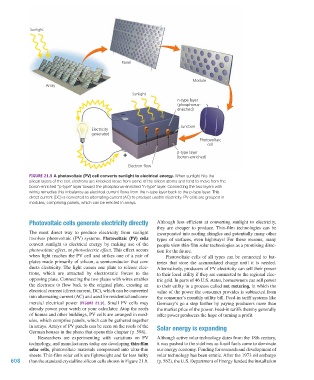Page 609 - Environment: The Science Behind the Stories
P. 609
Sunlight
Panel
Module
Array
Sunlight
n-type layer
(phosphorus-
enriched)
–
Junction
Electricity
generated
Photovoltaic
cell
+ p-type layer
(boron-enriched)
Electron flow
Figure 21.9 A photovoltaic (PV) cell converts sunlight to electrical energy. When sunlight hits the
silicon layers of the cell, electrons are knocked loose from some of the silicon atoms and tend to move from the
boron-enriched “p-type” layer toward the phosphorus-enriched “n-type” layer. Connecting the two layers with
wiring remedies this imbalance as electrical current flows from the n-type layer back to the p-type layer. This
direct current (DC) is converted to alternating current (AC) to produce usable electricity. PV cells are grouped in
modules, comprising panels, which can be erected in arrays.
Photovoltaic cells generate electricity directly Although less efficient at converting sunlight to electricity,
they are cheaper to produce. Thin-film technologies can be
The most direct way to produce electricity from sunlight incorporated into roofing shingles and potentially many other
involves photovoltaic (PV) systems. Photovoltaic (PV) cells types of surfaces, even highways! For these reasons, many
convert sunlight to electrical energy by making use of the people view thin-film solar technologies as a promising direc-
photovoltaic effect, or photoelectric effect. This effect occurs tion for the future.
when light reaches the PV cell and strikes one of a pair of Photovoltaic cells of all types can be connected to bat-
plates made primarily of silicon, a semiconductor that con- teries that store the accumulated charge until it is needed.
ducts electricity. The light causes one plate to release elec- Alternatively, producers of PV electricity can sell their power
trons, which are attracted by electrostatic forces to the to their local utility if they are connected to the regional elec-
opposing plate. Connecting the two plates with wires enables tric grid. In parts of 46 U.S. states, homeowners can sell power
the electrons to flow back to the original plate, creating an to their utility in a process called net metering, in which the
electrical current (direct current, DC), which can be converted value of the power the consumer provides is subtracted from
into alternating current (AC) and used for residential and com- the consumer’s monthly utility bill. Feed-in tariff systems like
mercial electrical power (Figure 21.9). Small PV cells may Germany’s go a step further by paying producers more than
already power your watch or your calculator. Atop the roofs the market price of the power. Feed-in tariffs thereby generally
of homes and other buildings, PV cells are arranged in mod- offer power producers the hope of turning a profit.
ules, which comprise panels, which can be gathered together
in arrays. Arrays of PV panels can be seen on the roofs of the Solar energy is expanding
German houses in the photo that opens this chapter (p. 598).
Researchers are experimenting with variations on PV Although active solar technology dates from the 18th century,
technology, and manufacturers today are developing thin-film it was pushed to the sidelines as fossil fuels came to dominate
solar cells, photovoltaic materials compressed into ultra-thin our energy economy. Funding for research and development of
sheets. Thin-film solar cells are lightweight and far less bulky solar technology has been erratic. After the 1973 oil embargo
608 than the standard crystalline silicon cells shown in Figure 21.9. (p. 562), the U.S. Department of Energy funded the installation
M21_WITH7428_05_SE_C21.indd 608 12/12/14 4:29 PM

